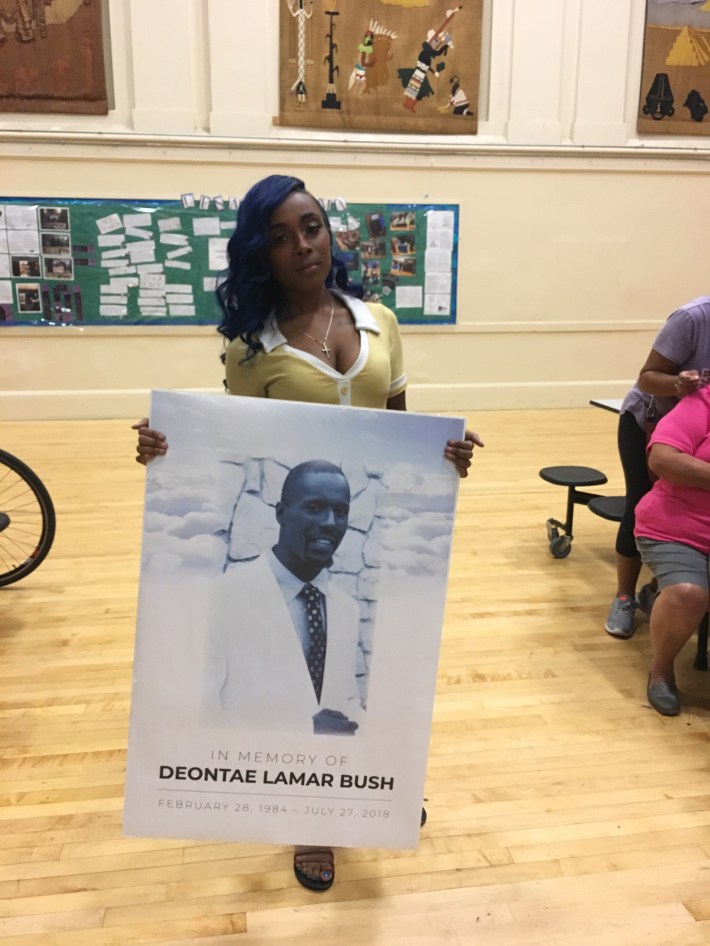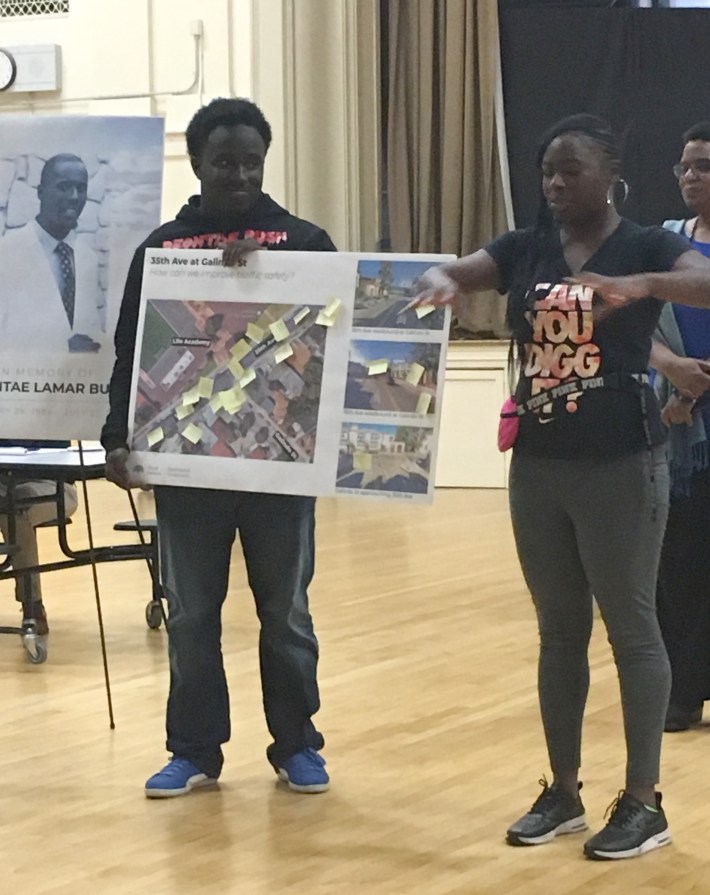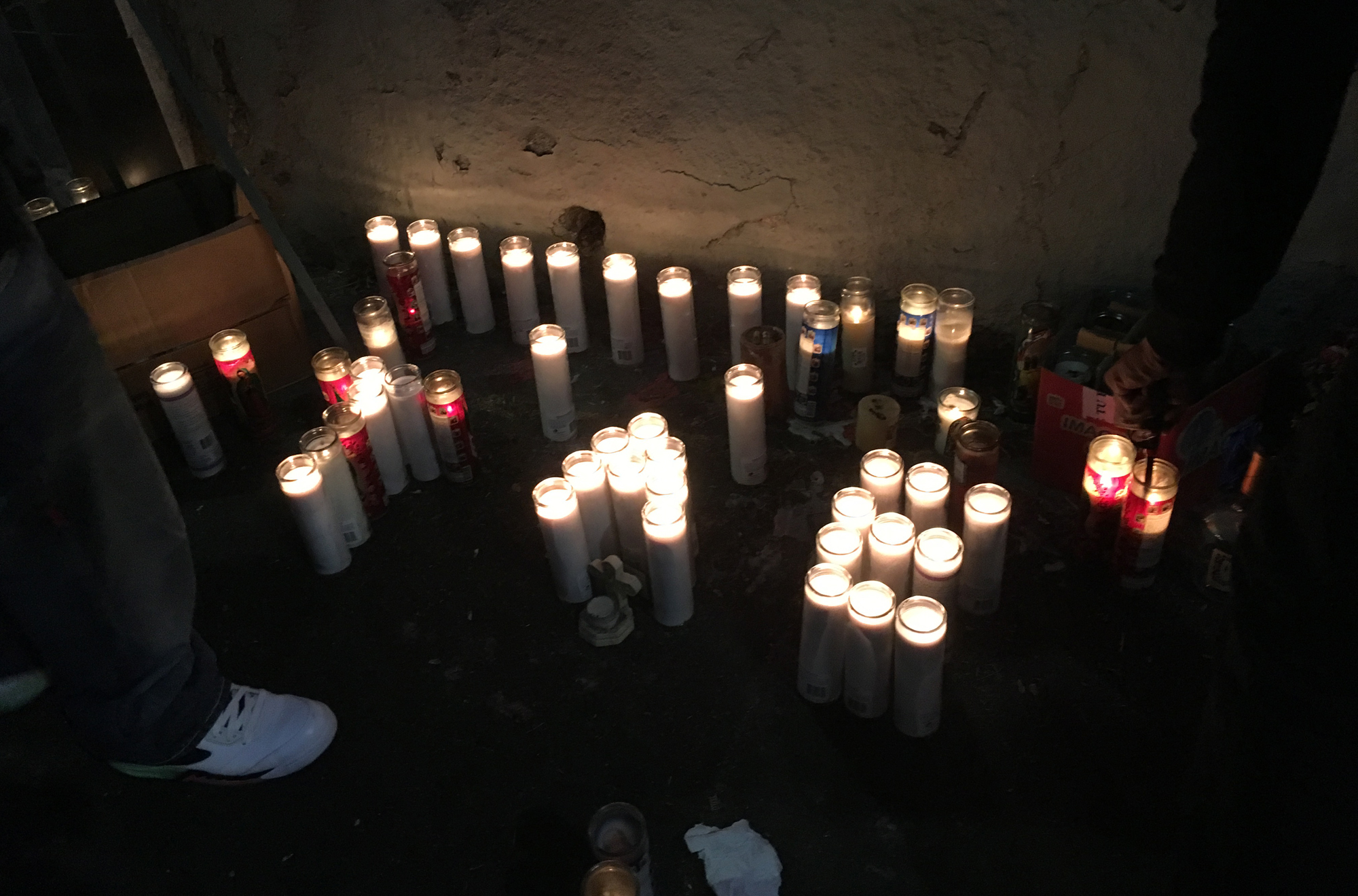The Oakland Department of Transportation held a meeting Monday evening in response to requests from the family of Deontae Lamar Bush, who was struck and killed on his bike by the driver of a van at 35th and Galindo on July 27.
The purpose of the meeting was “to honor and remember Mr. Bush,” said a flyer announcing the meeting. The city also wanted “to hear from residents about what pedestrian and bicycle safety concerns and solutions they want the Oakland Department of Transportation to consider.”
Bush's family had requested the meeting with the city because they were frustrated with the response they got from the police department after the crash. The circumstances of the crash remain unclear, but police say Bush was riding his bike downhill on Galindo and was struck by the van where Galindo tees into 35th Avenue. There is a signal there, but police haven't released any further details from their investigation, including what phase the signal was in, what the name of the driver is, or whether he had been tested for alcohol.
Anger boiled over at one point when Lt. Sean Fleming, speaking to the group, offered to meet privately with the family to go over their questions, but refused to answer them at the meeting. The investigation is not complete, he said, and he had no timeline for when it would be.

Family members, including Bush's sister Cherie McCullom, said they had not been treated respectfully by the police. McCollum asked why the police had told her mother that Bush was at fault for the crash before they had begun their investigations. “How are you so sure he was at fault?” asked McCullom. Another sister, Janice Bush, said the family had received little communication from the police, and had received no contact information for the investigators.
“We feel like our brother was treated as if he doesn't matter,” she said.
One attendee angrily took the Lieutenant to task for his body language when he addressed family members, saying by turning away physically from them he was showing disrespect.
Ryan Russo, OakDOT director, told the crowd of about forty family members and local residents that a group of city employees had come to listen to the community and learn from them. “Our job is to keep people safe. And we failed” in this case, he said. “Our job now is to make sure the same thing doesn't happen again to anyone else.”
The city has a $2.7 million federal grant to make safety changes in the area, said Russo, and they wanted to hear from the community how that money should be spent.
It seemed that some attendees were more interested in acknowledging the family's loss than discussing solutions. One woman gave a heartfelt speech in Spanish, offering condolences and saying she, too, had lost a son to traffic violence.

Nevertheless there was no shortage of ideas. Working in groups, community members and local residents studied maps and discussed their ideas—including changing the name of the street to recognize Deontae Bush.
Several pointed out that basic problems should have been fixed long ago. For example, one of the signal heads facing Galindo doesn't work, which may or may not have contributed to the crash. Street lights blink on and off, and at times the street in front of the school where the crash occurred is dark. The pavement is in bad shape, and red-light running is common. Every group wanted to see the installation of red light cameras along 35th.
Other suggestions: install flashing lights in the crosswalk “like they have in Alameda,” put in raised crosswalks and reflectors, create an alternate pick-up and drop-off spot for the school, add bike lanes, prohibit parking between 8 and 4, install better street lights “like around Lake Merritt.” Crossing guards, which used to help students cross 35th, need to be reinstated at all the schools along the avenue.
Better traffic enforcement will also be necessary, said residents. “If someone's going to run a red light, what difference is all of this going to make?” asked McCullom. The area needs motorcycle cops deployed here, and “not just one time, but regularly.”
Sean, a friend of Bush's who lives on Galindo, said that he sees “accident after accident” along 35th. “Cars parked on the curb have been hit, and the police won't come out,” he said. Another resident said that traffic is different during the week versus on the weekends. “Send someone out here on Friday and Saturday nights,” said one resident. “And just observe: there is a constant running of red lights here.”

One participant asked if the city had to wait for the grant money, or if immediate changes could be made—for example fixing the missing signal head and broken streetlights. “Some things will take time, and some actions can be taken quickly,” said Russo.
Another resident asked how the city could ensure that the $2.7 million would be spent to benefit the people who live in the area now and not just future residents.
At that point, Alvin Lester of Families for Safe Streets addressed the room. His organization was formed by families who have experienced a death or serious injury from traffic violence, and he had come to lend support to Bush's family. “Don't depend on others to give you the information you need,” he told the audience. “You go get it. And don't depend on public officials to drive this process—you drive it.”
The questions were summed up by McCullom at the end: “How can you make it so bicyclists don't have to fear for their safety anymore?” she asked.
Russo said he credited the family for demanding recognition and a response from the city. He said the information gathered at the meeting will help the city figure out the best course of action, as well as help inform other ongoing planning efforts like the city's bicycle plan update.
There was no timeline given.





